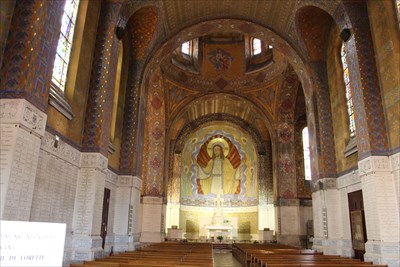
La Chapelle Notre-Dame-de-Lorette - Ablain-Saint-Nazaire, France
Posted by:  pmaupin
pmaupin
N 50° 24.063 E 002° 43.092
31U E 479972 N 5583260
[EN] The Notre-Dame-de-Lorette chapel is located in the center of the most necropolis of the First World War.
[FR] La chapelle Notre-Dame-de Lorette se trouve au centre de la plus nécropole de la première guerre mondiale.
Waymark Code: WMWADE
Location: Hauts-de-France, France
Date Posted: 08/02/2017
Views: 28

 The chapel of Notre-Dame-de-Lorette, which is also the work of Louis Marie Cordonnier, is a Roman-Byzantine type building 46 m long and 14 m wide.
The chapel of Notre-Dame-de-Lorette, which is also the work of Louis Marie Cordonnier, is a Roman-Byzantine type building 46 m long and 14 m wide.
It is surmounted by a dome, at the crossing of the transept, which culminates at 34 meters in height. It is adorned with reconstituted Givet stone is in the shape of a Latin cross.
It was inaugurated on 2 August 1925 by the President of the Council Paul Painlevé, then blessed on 26 May 1927 by Bishop Julien, Bishop of Arras.
It is in the center of a necropolis of 42000 soldiers (20 000 known and 22000 unknown).
The stained glass windows are the work of the master-glass-maker chartrain Charles Lorin from the drawings of Henri Pinta. Six stained glass windows of the transept of the chapel, offered by the British (by the Imperial commission of the British military burials), were executed by the English artist Henry Payne.
The work of the mosaics inside the chapel was carried out by the workshops of Félix Gaudin.
The construction of the necropolis and the construction of the lantern tower and the basilica chapel were rendered particularly difficult by the poor quality of the land, the lack of access to supply the building site with materials and the very harsh climate Of the plateau.
The Latin quotation on the bow in front of the main entrance is a biblical quotation from 2 Samuel 1.19 (II Reg 1.18 according to the Vulgate Clementine version): "So your glory, Israel, perished on the heights? How did the heroes fall? (According to the translation Pirot-Clamer / Liénart).
Sources : Notre-Dame-de-Lorette


 La chapelle de Notre-Dame-de-Lorette qui est aussi l'œuvre de Louis Marie Cordonnier, est un édifice de type romano-byzantin de 46 m de longueur et de 14 m de largeur.
La chapelle de Notre-Dame-de-Lorette qui est aussi l'œuvre de Louis Marie Cordonnier, est un édifice de type romano-byzantin de 46 m de longueur et de 14 m de largeur.
Elle est surmontée d’une coupole, à la croisée du transept, qui culmine à 34 mètres de hauteur. Elle est parée de pierre de Givet reconstituée est en forme de croix latine.
Elle est inaugurée le 2 août 1925 par le président du Conseil Paul Painlevé, puis bénie le 26 mai 1927 par Mgr Julien, évêque d'Arras.
Elle est au centre d'une nécropole de 42000 soldats (20000 connus et 22000 inconnus).
Les vitraux sont l’œuvre du maître-verrier chartrain Charles Lorin d’après les dessins de Henri Pinta. Six vitraux du transept de la chapelle, offerts par les Britanniques (par la commission impériale des sépultures militaires britanniques), ont été exécutés par l’artiste anglais Henry Payne (en).
Les travaux des mosaïques de l’intérieur de la chapelle ont été réalisés par les ateliers de Félix Gaudin.
L'aménagement de la nécropole et la construction de la tour-lanterne et de la chapelle-basilique ont été rendus particulièrement difficiles par la mauvaise qualité du terrain, le manque d’accès pour l’approvisionnement du chantier en matériaux et le climat très rude du plateau.
La citation en latin qui figure sur l'arc devant l'entrée principale est une citation biblique tirée de 2 Samuel 1.19 (II Reg 1.18 selon la version Vulgate Clémentine) : « Ta gloire, Israël, a donc péri sur les hauteurs ? Comment sont tombés les héros ? » (selon la traduction Pirot-Clamer/Liénart).
Sources : Notre Dame de Lorette